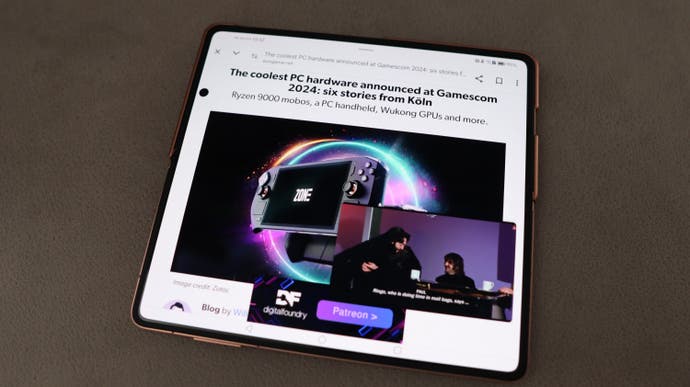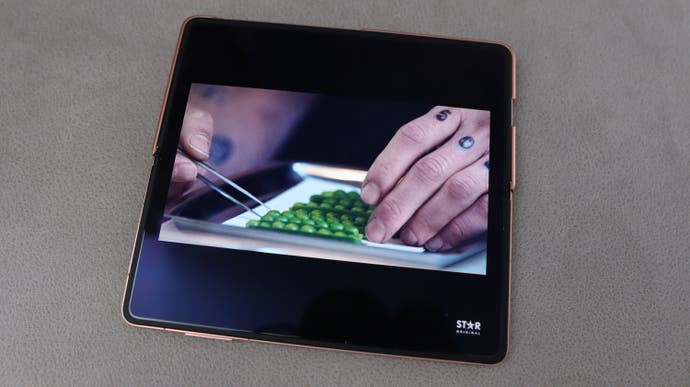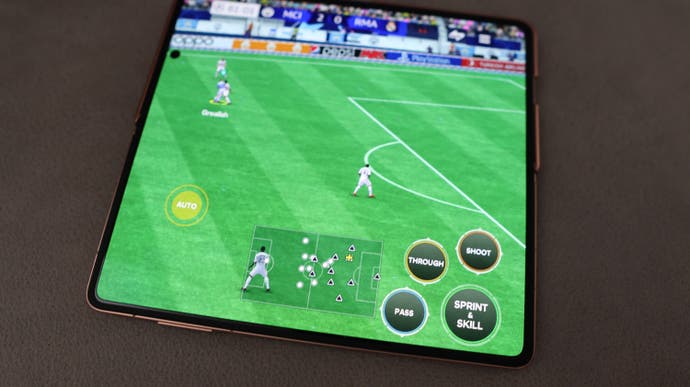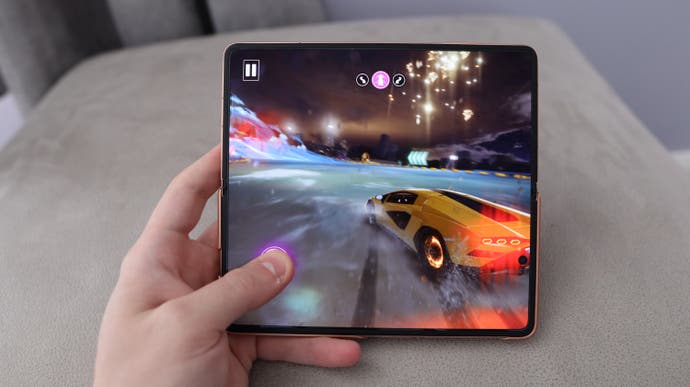Honor Magic V3 review: once again, progress is being made in the foldable phone space
Thinner, more powerful, and of course there's AI.
The Honor Magic V3 is a serious feat of engineering, packing a bigger battery, more advanced camera setup and more powerful specs than its predecessor into a phone that's both thinner and lighter. Like the latest foldables from Samung and Google, it feels like there's once again solid progress being made in the foldable space.
All of this comes at a steep cost, of course - the £1400/€1700 outlay is eye-watering - but you're at least getting a bang-up-to-date spec sheet, including a new Qualcomm Snapdragon 8 Gen 3 SoC, 12GB of RAM and 512GB of storage. As for its triple camera setup, this now includes a 50-megapixel wide-angle shooter, a 50-megapixel periscope telephoto and an upgraded 40-megapixel ultrawide. There's also a bigger 5150mAh battery, as well as a pair of LTPO OLED screens - the 7.92-inch foldable screen and 6.43-inch cover display.
Design
The Honor Magic V3 is available in three different colours - Black, Green or the Reddish Brown we received. It's more on the red side, but offers a terracotta-type colourway that looks fantastic. It's pleasant to see something a little different to the sea of grey and black slabs we've become used to in the phone world. Combined with the rose-gold accents on the side of the Magic V3, it looks excellent. Against the Magic V2 RSR Porsche Design we looked at earlier this year, the standard Magic V3's back panel is entirely flat, but with a textured, leather-type finish. Its camera bump is more pronounced with a large black circle and a glossy, hexagonal rose-gold edging that's in-keeping with the rest of the phone.

Even in spite of the larger camera bump, the Magic V3 manages to be an even slimmer phone that its predecessor. I'm not entirely sure how, but Honor has managed to trim down this phone to be just 9.2mm, a full 0.7mm slimmer than the Magic V2. For reference, the new Samsung Z Fold 6 is 12.2mm and Google's Pixel 9 Pro Fold is 10.5mm thick. Honor's option remains the only one to break the elusive 10mm barrier in quite an exciting game of foldable phone limbo.
It has the effect of meaning the Magic V3 is the most pocketable foldable I've had my hands on, lacking the noticeable pocket bulge you'd expect from a handset with two screens. Even with the excellent included case on, it doesn't feel like I've got a thick, hefty phone in my pocket - that's also down to its lower 226g weight.
That lower weight also goes a long way to making the Magic V3 an especially comfortable phone to hold, and you can certainly use it one-handed. You'll have to ensure you hold it tight when folded out, though, just to ensure you keep a good grip on it. Luckily, the Super Fiber material Honor has employed on the back of the Magic V3 is not only immensely durable, but its textured finish helps to make the phone easy to hold.

In a general sense, the Magic V3 is also just a gorgeous handset, with especially thin bezels around both the larger fold-out display and the smaller cover screen. As with the previous model though, there is potential for ingress of small pieces of dust and debris around the screen. The Magic V3 also uses a new style Honor Super Steel hinge, which the brand claims is stronger and more durable than that found on the Z Fold 6 and 41 percent thinner than other foldable hinges, helping to contribute to the handset's slender status.
Honor has handily upgraded the water resistance rating of the Magic V3 against the older Magic V2, with an IPX8 rating. This is pleasant to see and matches the Pixel 9 Pro Fold's rating, although both lag behind the Z Fold 6's new and improved IP48 rating (as 'X' indicates no level of claimed dust resistance, and '4' is some level of dust resistance).
Display
The Magic V3's pair of panels may not constitute much of an upgrade over the Magic V2, although there are some notable changes, such as a higher peak brightness of 1800 nits where the previous phone could manage 1600 for the 7.92-inch main screen. In addition, the smaller 6.43-inch cover display can now offer up to 5000 nits peak brightness, which is hilarious, and with the benefit of HDR, of course.
As much as it may be easy to play down the minor upgrades to the Magic V3's displays, it's worth noting just how excellent they are. The 7.92-inch main display remains one of the largest panels found on a foldable, only being beaten by the 8-inch main display on the new Google Pixel 9 Pro Fold. It's an especially detailed screen with both a 2156x2344 resolution and high 402ppi pixel density, while its boosted peak brightness and Dolby Vision support ensure fantastic viewing experiences all-round. It's also a adaptive refresh rate display up to 120Hz, helping it to feel seriously responsive. You also can't notice the crease on the main display unless viewed from extreme angles.

The 6.43-inch cover display, much like its predecessor, is also a top-class choice, packing in evne more oomph than the bigger display on the reverse. This is , of course, down to a quite frankly ridiculous 5000 nits of peak brightness for immense HDR performance and solid 2376x1060 resolution which helps make it a joy to use for eveything from gaming and movie watching to general browsing. If you wanted to use the Magic V3 as a more conventional phone for some of the time, it's nice to know how good that cover display can be.

Certain apps and content will have a letterbox effect through not filling the screen entirely, but you can force apps and games on a individual basis to fill the screen so you can take advantage of the full 7.92 inches of real estate.
Camera
The triple camera setup inside the Magic V3 has also been slightly beefed up to offer a 50-megapixel wide sensor, a 40-megapixel ultrawide and a 50-megapixel periscope telephoto, which sees some interesting performance across the board. The main 50-megapixel snapper here served up detailed photos with crisp colours and solid dynamic range.
Detail is fantastic across the board with excellent colours, although they can look a smidgen oversaturated at times, such as the greens on the Torbay palms in the sample images. The 3.5x optical zoom pulled in some great quality on the periscope telephoto, which is a big upgrade on the previous handset, such as on the sample photo I took of the view out of my office window.
The 10x digital zoom also served up some decent detail, with less blurriness than the Magic V2, although when you get up to 30x and beyond, there is a lack of finesse. The Magic V3's camera setup offers up to 100x digital zoom if you want it though, up from the maximum 40x of the V2, for super far out shots.
Low-light performance is also solid too with excellent detail levels. It's noticeably sharper than the Magic V2 and pushes Samsung's recent offerings in terms of performance. There doesn't seem to be the same level of fuzziness here as there was with the Magic V2 either, while even in situations with very little light, the camera manages to offer enough light without it being overblown and overexposed.
The front cameras have also seen a notable upgrade too, with both the cover display and main panel coming with 20-megapixel selfie options, as opposed to 16-megapixel ones on the Magic V2. They're neutral in their colours, with solid detail and contrast. Of course, as this is a foldable phone, it's worth noting that you can prop the phone up and use the much more competent rear lenses for taking vain photos of yourself.
Performance
I'm impressed with the performance of the Magic V3 overall, even if its gaming benchmark results in the GFXBench suite are only marginally better than that of the Magic V2, Nonetheless, the Snapdragon 8 Gen 3 SoC has provdided a small boost in performance here, while coming with a larger increase in our other benchmark tests.
| Benchmark | Honor Magic V3 | Honor Magic V2 RSR | Sony Xperia 5 V |
|---|---|---|---|
| Geekbench 6 Single Core | 2214 | 2030 | 2069 |
| Geekbench 6 Multi Core | 5699 | 4928 | 5585 |
| 3DMark Wild Life Extreme | 4471 | 3748 | 3725 |
| GFX Aztec Ruins High Tier | 46fps | 46fps | 59fps |
| GFX Car Chase | 57fps | 56fps | 60fps |
| PCMark Work 3.0 | 17419 | 14089 | 12466 |
On the front of gaming workloads however, such as in GFX Car Chase and GFX Aztec Ruins High Tier, the Magic V3 offers virtually identical performance to its predecessor, while serving up solid results for gaming on the high-res main display.
What's intriguing though, is if you run the tests on the smaller 6.43-inch cover display, results get a lot better, with both Car Chase and Aztec Ruins High Tier spitting out high-riding scores of 116fps and 94fps respectively. These are more in line with scores we've seen with the Magic 6 Pro in our testing, proving the Magic V3 does have some grunt after all, and if used in the same way as a more conventional handset such as the OnePlus 12R offers some serious performance.

The likes of COD Mobile and EAFC Mobile proved immersive and responsive with the combo of the Snapdragon 8 Gen 3's power and the larger 7.92-inch display, while jumping into Asphalt 9 yielded similar results. Under load when playing these titles, the Magic V3 didn't get too toasty and while warm, it wasn't too hot to handle, unlike some other handsets I've used in the past.
The Magic V3 unfortunately suffers from a similar degree of performance drop-off under extended loads as the Magic 6 Pro does, largely owing to its use of the Snapdragon 8 Gen 3 chip. In the 20 minute 3D Mark Wild Life Extreme Stress Test over its 20 runs, it recorded a 52 percent performance drop, although its thermals weren't as hot as other phones. That's largely due to its titanium-based vapor chamber inside for cooling, which is much-improved against the Magic V2.

Our review sample shipped with the 12GB/512GB combination, offering solid RAM headroom for those more intensive workloads, as well as a fair amount of storage space for installing lots of apps and having a decent set of physical media such as photos or music on. As with the Magic V2 though, the storage on the Magic V3 isn't expandable with a Micro SD card slot, though.

In terms of its software, as with the Magic 6 Pro, the Magic V3 foldable ships with Honor's MagicOS 8, which is based on Android 14. It's by no means a bad version of Android, shipping with more of an iOS feel to it to the point where MagicOS 8 comes with both the same kind of dynamic wallpapers and notification centre when you swipe down from the top of the screen. For me at least, it isn't as slick as Samsung's OneUI.
With this in mind though, there are features here that are well-suited for the Magic V3, such as having up to four windows open at once for serious multi-tasking. That's two in split screen, and another pair in smaller, floating windows. In addition, apps can run full-screen when the main screen is folded out, although you do have to force them to do so indivudually, which is a pain. I don't really want to have to go through every individual app and force it to full screen.
Of course, being a 2024 handset means the Magic V3 also comes with AI goodness (or not so goodness, depending on your perspective), such as the AI Eraser in the Gallery app. This works in a similar way to the Magic Eraser found on Google Pixel phones, and has made its way to various other Android skins with a recent update. It can remove unwanted things from images, such as people in the background or needless foreground detail. You simply circle the item you want to delete or move around, and the phone's AI does its work to try and remove it, or generate something new in its place, with varying degrees of success.
Besides this, the Magic V3 also has Face To Face translation, which has been a feature most touted on Samsung's Galaxy ZFlip 6 handset. In essence, it can do live translation on the main display and cover display, if you're having a conversation between two people, which is seriously useful. You also get Honor AI Notes, which can transcribe and translate speech in situations such as meetings, and the same Magic Portal feature as on the Magic 6 Pro. This allows you to drag and drop text from a search directly into a selection of apps by holding down on the text you want to copy and then drag it to a vertical edge of the screen. For instance, if you want to put an address directly into Google Maps without exiting out into Maps and then back to Chrome to make sure you got the address right, then it makes life a fair bit easier.
The Apple and iOS comparisons also continue with Honor's Magic Capsule which works like Dynamic Island does on modern iPhones. It provides simple control of apps such as the Clock for setting timers and for answering phone calls via the holepunch front camera at the top of either the cover or main display.
Unlike the Magic V2, the Magic V3 also comes with its own gaming mode, with is less extensive than the one that comes with the Sony Xperia 5 V, but I'm still pleased it's here. It provides convenient access at the left hand of the screen for basic features such as a rotation lock and screen recorder, as well as more advanced ones for adding filters to change the look of a game, or a touch enhancer for more responsive inputs. A lot of these options are either on or off, as opposed to having any granular control.
Honor has also pledged four years' worth of software updates and five years of security patches with MagicOS, which is reasonable, although sits behind both Samsung and Google's own committments of seven OS upgrades' worth of support.
In spite of all these additions, there are some issues with MagicOS 8 that prevent it from becoming my favourite version of Android. For instance, it comes with Honor's own 'Essentials' folder right on the front screen, but you have to be precise on where you put your finger to open the specific app. Tapping the folder doesn't open it into a larger one where you can see the apps inside. In addition, there is unwanted crud installed, such as AliExpress, Facebook, TikTok and Booking.com, all of which I uninstalled. I don't really want bloatware on a phone that costs this much.
Battery Life
It appears Honor has learnt their lesson with the Magic V3 by including a 66W USB-C power brick and cable inside the box alongside a leather case, which were only included with the RSR version of the previous phone. This means you're essentially ready to go out of the box, without needing to hunt around for a higher wattage charger.
The Magic V3 also benefits from a larger capacity battery at 5150mAh, which is incredible in a foldable phone that's this thin, especially as foldables have so often sacrificed battery life due to the constraints on the type of phone they are. The batteries themselves are also just 2.6mm thick, which are ever-so slightly thinner than the Magic V2's cells, which is a feat of engineering in itself.
The cells inside the Magic V3 are also silicon-carbon, as in the Magic 6 Pro. This has a couple of important benefits, such as being able to work in much colder environments and being better for the planet than standard lithium-ion batteries.
In my testing, I managed to get a couple of days' use out of the Magic V3, which is excellent, while the PCMark V3.0 benchmark served up a result of 9hrs 32 minutes at 50 percent brightness, which is reasonable screen-on time for a foldable. In addition, charging with the 66W USB-C power brick was brisk. The Magic V3 also benefits from proper support for wireless charging too, with up to 50W wireless charging available with a compatible charger.
Conclusion
The Honor Magic V3 may well be a small upgrade on its predecessor, but it's these little refinements that for the most part help it to become the best foldable I've used. It's got a fantastic set of displays with excellent brightness and contrast, as well as serious levels of power with that Snapdragon 8 Gen 3 chip inside.
What's more, it also benefits from being seriously thin at just 9.2mm, and as much as it's a record-breaking inclusion, it helps the Magic V3 feel lighter and sleeker than its predecessor. I its reddish-brown and rose gold accented colourway, it also looks gorgeous, while its battery life is reasonable, too, with uprated wireless charging support a handy bonus. The upgraded triple camera setup with that periscope telephoto lens is also a highlight, with boosted zoom and much more competent low light performance overall.
For £1400/€1700, the Honor Magic V3 sits where it should against the likes of the Samsung Galaxy Z Fold 6 and Google Pixel 9 Pro Fold, and continues to stake Honor's claim to offering a seriously brilliant folding phone.




















